THE ARCHAEOLOGY OF POST-MODERNITY
E.R.E. KNUTSSON
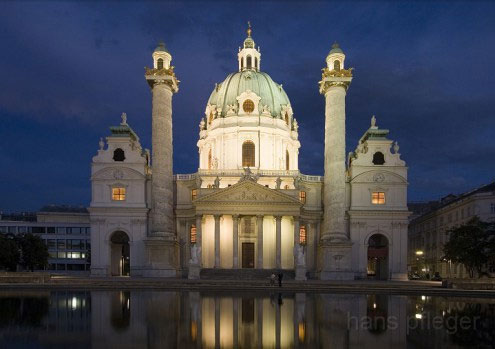
Part I: Viennese Mutations
The long-term destiny of the Western world has been a movement from pre-modern "Providence" via modern "Progress" to postmodern "Nihilism". Providentialism's linear future-oriented focus—emphasizing the role of reason to the detriment of divine intervention—easily merged with the Enlightenment idea of Progress, paving the way for the rise of modern science. The Enlightenment project, designed to eliminate uncertainty and ambivalence, was gradually undermined by postmodern inversion, implosion, relativism and nihilism.
The resulting "postmodern condition" calls for an investigation into the archaeology of post-modernity. Excavations of this kind are likely to encounter layers of 19th and 20th-century answers to 21st-century questions. A privileged site to start looking for answers is Vienna—"the capital of the 20th century."
Metropolises such as Vienna, Berlin, Budapest, Prague, St. Petersburg and New York–19th and early 20th-century cityscapes with significant Jewish Diasporas and epicenters of a widely felt civilizational crisis—were scenes or "laboratories" for intense, sub-counter-cultural "experiments" and avant-garde strategies designing prototypes of a future hybridized, postmodern world. Viennese modernism represents, according to Jacques Le Rider, "the appearance of a post-modern moment in the history of European culture." The Jewish satirist Karl Kraus damned Vienna as a "research laboratory for world destruction."
The revolution of (proto-post-)modernism entailed an increasing separation of representation from "the real." In this context, the pseudo-assimilated Jew has been seen as "the prototype of the post-modern self." Major themes of the Kulturkritik of the 1970s and 1980s, Jacques Le Rider points out, were prefigured in the Viennese modernism of 1900.
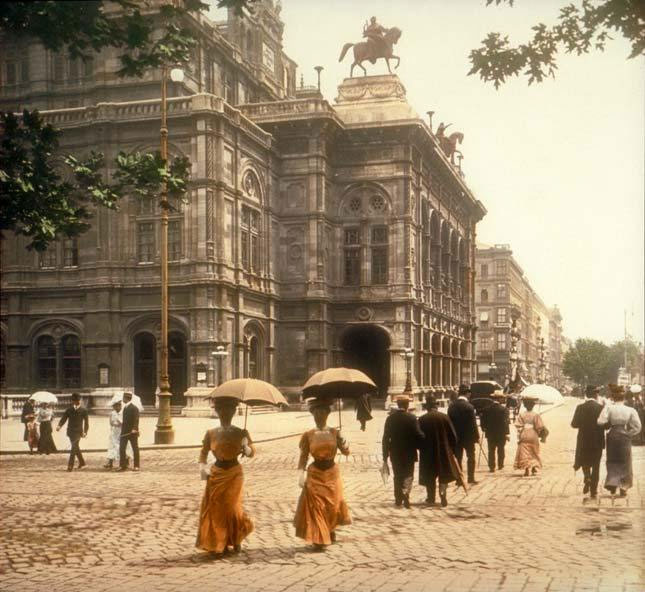
Vienna: "The Capital of the 20th Century"
At the turn of the 20th century Vienna was one of Europe's largest urban centers, with a population of more than two million by 1910. By then, Vienna had been a major centre of political power and cultural patronage for centuries. Vienna was a place of tensions and paradox: Its mayor, Karl Lueger, had anti-Semitic inclinations. Vienna sheltered both Theodor Herzl—the founder of Zionism—and Adolf Hitler, the founder of National Socialism. The city's numerous innovative cultural and intellectual movements and figures radically changed Western culture and thought, according to Steven Beller:
Leading a very long list are two intellectual giants: Sigmund Freud, the founder of psychoanalysis, and Ludwig Wittgenstein, one of the most influential philosophers of the modern era. … Hans Kelsen revolutionized the theory of law; the Austrian School of Economics had a large influence on liberal economic thought; the Vienna Circle of philosophers developed logical positivism, and Karl Popper acted as that movement's leading critic; Alfred Adler developed individual psychology, the first of many rebels from Freudian orthodoxy who established their own movements; Austro-Marxism brought innovative reinterpretations of socialist theory. Vienna also became a powerhouse of literary innovation: Arthur Schnitzler, Hugo von Hofmannsthal, Karl Kraus, Hermann Broch, Robert Musil, Stefan Zweig and Franz Werfel, later Elias Canetti, were but the most prominent among a vast array of writers. It is the depth of intellectuality and talent that is perhaps the most impressive part of Vienna 1900.
Viennese "critical modernism" had its roots in French decadence, the positivism of physicist Ernst Mach and the "Dionysian" influence of Richard Wagner and Friedrich Nietzsche. Nietzsche had, in the words of Joan Peyser, "repudiated nineteenth-century ideology and demanded the reorganization of human society under the guidance of exceptional leaders. Richard Wagner answered the call" and became "the German superhero, the embodiment of the Dionysian ideal for which Nietzsche yearned."
Vienna circa 1900 was, as Steven Beller points out, "a vibrant centre of radical cultural and intellectual innovation, with consequences that reverberated through the twentieth century." Its culture was heavily influenced by the largest Jewish community in Western Europe:
In Vienna especially the Jewish role was predominant. Some of the major figures of Viennese modern culture … such as Adolf Loos and Georg Trakl, Ernst Mach and Ludwig Boltzmann, were not Jewish, but the vast majority were. The Jewish presence among creative figures in the plastic arts was not that large, although Jews were prominent as patrons, art critics and propagandists, and eventually as art historians. In most other modern cultural fields … such as psychoanalysis, the Vienna Circle, Austro-Marxism and literary Young Vienna, the people involved were in a large majority Jewish or of Jewish descent. The liberal professions—lawyers, physicians and journalists—also had a majority Jewish presence, and it has often been claimed that the public for Viennese modern culture was also heavily Jewish. This Jewish predominance was based on solid socio-economic grounds, for the social reservoir of Viennese modern culture, the educated part of the liberal wing of the city's bourgeoisie, was largely Jewish.
Jews comprised 10 per cent or so of Vienna's population, and less, about 3 per cent, of the population of the lands of the later Austrian Republic. Yet Jews had a large presence in Vienna's liberal socio-economic sectors, being 30 per cent of Vienna's commercial self-employed. According to Beller, the Jewish emphasis on education was also much greater than normal:
"Approximately two-thirds of all boys with a liberal bourgeois background who graduated from Vienna's central Gymnasien [the elite secondary schools] between 1870 and 1910 were Jewish. (The equivalent proportion among girls was higher still.)"
As Louis Breger notes,
The new religious freedom that followed the German revolution of 1848 was accompanied by the lifting of restrictions and special taxes that Jews had suffered for many years. Now, they enjoyed the rights of full citizens; the professions were open to them, they could employ Christian servants, own real estate and live outside the ghettos. These new opportunities had stimulated a flood of Jewish immigrants from the provinces during the second half of the nineteenth century. In 1860, there were 6,000 Jews in Vienna; by 1900, the number was 147.000, the largest Jewish community of any country in Western Europe. In the capital, they found expanding economic, educational, and cultural avenues; by the turn of the century, they were a powerful presence in banking and industry, in medicine, law, journalism, literature, and music.
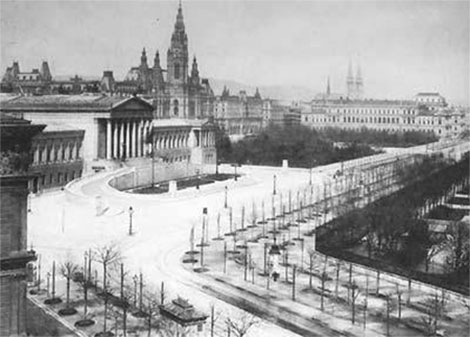
“The whole Ringstrasse had a magic effect upon me,
as if it were a scene from the Thousand-and-one-Nights.” (Adolf Hitler)
Members of the Austrian nobility considered it beneath their station to engage in trade, finance, and the professions, leaving these fields open to enterprising and educated Jews who were able to achieve positions of wealth and prominence. By the latter half of the 19th century, they dominated a number of fields. As Louis Breger observes:
By the 1880s, 12 percent of the population of Vienna was Jewish, yet they made up one-third of the student body of the university, with even higher numbers in certain fields: 50 percent in medicine and almost 60 percent in law. All the liberal newspapers were owned by Jews and a large proportion of the journalists were Jewish. As the turn of the century approached, the majority of the liberal, educated, intellectual elite of Vienna was Jewish. The politicians Victor Adler—brother-in-law of Freud's school friend Heinrich Braun—and Otto Bauer—older brother of the woman who became his famous case, "Dora"; the journalist Karl Kraus; the writers Arthur Schnitzler, Hugo von Hofmannsthal, and Stefan Zweig; the composers Gustav Mahler, Arnold Schoenberg, and Alban Berg — all came from Jewish families.Leon Botstein points out that the Jewish presence in Vienna "increased from less than half of 1 per cent in Vienna of Schubert's day, to around 5 per cent in 1862 when Brahms settled in the city, to over 10 per cent when Mahler left for Kassel in 1883. The Vienna in which Mahler died comprised over 175,000 Jews; the city he first encountered in 1875 comprised only about 55,000."
Modernity attracted Jews from the periphery toward the center—as Philip V. Bohlman observes—"to the metropole, to the cosmopolitan culture of modernism, to the arts and sciences fostered by great universities, to the monumental synagogues, and to the concert halls and cabarets." Jewish modernism took shape as a counter-history to the rise of European modernism, and Jewish music in the modern era inscribed its otherness "in such ways that it would circulate in a modern public sphere." During the modern era, Bohlman points out, "the otherness of the [European] periphery increasingly shifted towards the center":
Europe and the Enlightenment, and its Jewish form, the Haskala … are keys to understanding a revolutionary transition in Jewish music and Jewish music history. … Before the modernity articulated by Moses Mendelssohn and other … Jewish Enlightenment thinkers, "music" was largely vague as an aesthetically autonomous object in Jewish society. In a strict sense everything in the synagogue was music—prayer, Torah and Haftorah, cantillation, ritual and liturgical interjection—therefore it was impossible to limit it to any single category. … The cyclical nature of liturgical practices bounded music within ritual and prevented it from flowing over into the temporal world outside the synagogue.
As Jews from the eastern parts of the Austro-Hungarian Empire "flooded the metropole" (i.e. Vienna), a new Jewish popular music took shape, trading in stories that "chronicled a new city culture in the liminal space between tradition and modernity." The musical traditions these new immigrants brought with them gradually spread through the public sphere. As Bohlman points out,
One of the most important conditions for the complex new popular music was language. Each stream of immigration from a different part of the empire brought with it different dialects, which in turn were distinct from the other dialects found in Vienna.… Speech and language played a further role in the historical transformation of Jewish music, not least because of the partial supplanting of Hebrew with German in the synagogue.… The proliferation of Jewish dialects of German and different dialects of Yiddish in Vienna had a profound impact on the city's popular culture.…The Wiener Mundart (Viennese dialect) that contributed to the formation of the genre known as Wienerlied (literally, Viennese song, but referring to an extensive repertory of popular song in Viennese dialect) bears direct witness to the specific influences of Jewish dialects.
Jewish composers in early 20th-century Europe formulated a vocabulary of melodic patterns and motivic meaning that allowed some of them—Ernest Bloch, Arnold Schoenberg, among others—to create repertories that contained specifically Jewish symbolism. Max Brod (1884–1968)—the Jewish music critic, composer, philosopher, and future champion of Franz Kafka— established in an essay ("Jewish Folk Melodies", 1916) the conditions for the Jewishness in Gustav Mahler's music and by extension in modern Jewish music. As Bohlman observes,
Brod's essay … turned the Jewish question many were posing inside out by claiming that what was presumably the most German trait of Mahler's style, the march, was an expression of Jewishness.… The march style Brod ascribed to Mahler was religious and hassidic, even further removed from the firsthand experiences of Mahler's lifetime. Mahler's musical connection was possible, therefore, because of his "Jewish soul," which was internal and thus contrasted with his merely "external consciousness" of German music.
Theodor Adorno also searched for Mahler's "inner identities" by reflecting on his "musical physiognomy." This search for Jewishness that preoccupied Brod and other 20th-century Jewish observers produced a constellation of themes orbiting Mahler's music, claiming that it included—in Bohlman's words—"specifically Jewish gestures, presumably absorbed from growing up in the Jewish soundscape of provincial Moravia."
Mahler's hometown Iglau contained one of the oldest Jewish communities in Moravia—a region well-known as the home to influential Talmudic scholars and famous rabbinical dynasties. Like many Moravian and Bohemian towns, Iglau was a German-speaking enclave within a larger Czech-speaking rural society. Czech was the language of farmers and peasants; German was the language of success and social advancement, the language of the educated, urban elites and the imperial bureaucracy. Mahler famously remarked that he was "thrice homeless: as a Czech among Austrians, as an Austrian among Germans, and as a Jew throughout the world." But Mahler was in "good company" as a prominent cultural figure of fin-de-siècle Vienna descended from the Crown Lands of Bohemia and Moravia: His fellow Bohemian Jews included Victor Adler, Otto Bauer, Richard Beer-Hofmann, Hermann Broch, Egon Friedell, Karl Kraus, Stefan Zweig, Sigmund Freud, Guido Adler, Otto Neurath, Ludwig Wittgenstein, Max Reinhardt, Arnold Schoenberg, and Otto Weininger.
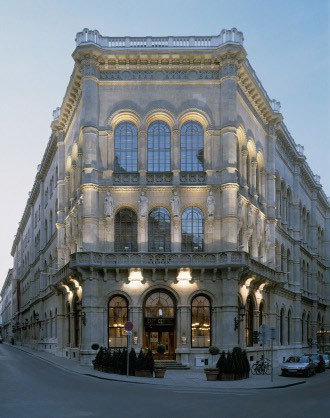
a key meeting place for intellectuals in late-19th-century Vienna
It has been argued that Mahler's music has links back to the Hasidic music of Eastern European ghettos of the eighteenth century in which dance music is deployed as a remedy to misery: "Mahler's lifelong juxtaposition of funeral march and dance music, dating back to his earliest childhood composition (a polka with funeral march introduction), is thus related to a specifically Jewish tradition. The Trio of the third movement of the First Symphony, with its interpolation of street music into the funeral march, is heard by many as an example of klezmer music as Mahler would have heard as a child and would have been heard on the streets of Vienna during his time there." As Philip Bohlman points out,
Mahler's marginality as a Jew, so his late twentieth-century champions claimed, exposed him to cultural contexts distinguished by jarring juxtapositions and pieces that failed to cohere as wholes. Mahler therefore employed the musical language of bricolage, somehow characteristic of a Jewish preference for hybridity over unity.
Rudolf Louis, one of Mahler's critics, summarized it thus in 1909: "What I find so utterly repellent about Mahler's music is the pronounced Jewishness of its underlying character. … It is abhorrent to me because it speaks Yiddish. In other words it speaks the language of German music but with an accent, with the intonation and above all with the gestures of the Easterner, the all-too-Eastern Jew." Louis's choice of words, according to Julian Johnson, "underlines something true about Mahler's music: it speaks the language of the Austro-German tradition but with a different tone, accent, and voice. It remains contested whether this difference is explained by Mahler's Jewish origins … or whether it results from a modernist attitude toward language (marked by irony, parody, exaggeration) that exceeds the specific category of Jewish identity."
Despite his conversion, there was never any doubt in Vienna that Mahler was Jewish. As Leon Botstein points out, "Jewish identity was no mere matter of an individual's theological practices or convictions. In the eyes of Jews and anti-Semites alike, it was a matter of birth, race, and nation, as well as faith."
It has been suggested, that Mahler's music reflects the tragic Weltgefühl of his era. Julian Johnson points out that Mahler's music is like "an acoustic prism placed at the end of one century and the beginning of another, refracting musical voices from both historical directions, from Viennese classicism and early romanticism to the stylistic eclecticism and polyvocality of the twentieth century."
The Archaeology of Postmodernity, Part II: The Emancipation of Dissonance
From an "archaeological" point of view, there are several striking parallels between early 20th-century Austria (as exemplified by the case of Vienna) and early 21st-century America. The easiest ones to unearth are these: increasingly intense minority activism (encouraged by laissez faire policies), a gradual breakdown of the hegemony of the national language and traditional culture, accompanied by a demographic shift away from the country's Traditionskern — its Germanic ethno-cultural core.
At the turn of the 20th century, Vienna—as the center of the multi-ethnic state of the Habsburg Empire—sheltered a hodgepodge of nationalities, language groups, religious confessions, avant-garde artists, renowned scientists, and rebellious intellectuals who "comingled to give rise to a unique cultural ambiance." The ethnic minorities most abundantly represented were the Czechs and the Jews, followed by the Poles and Hungarians. Jacques Le Rider points out that "the xenophobia aroused by the growth of the Czech colony, and the spread of anti-Semitism made Vienna an ethnic battlefield rather than a melting pot." The unresolved nationality conflicts "were sapping the foundations of the Monarchy", according to Robert S. Wistrich.
As Stefan Newerkla points out, the basically tolerant laws "provided for the right to have education in one's native language and stated that no citizen should be forced to learn the language of any other ethnic group." Language became a prominent site for inter-ethnic con-flicts. Thomas Wallnig emphasizes the fatal consequences of "the mas-sive struggle between the national-ities that marked the final decades of the Habsburg monarchy;" the state was "unable to establish "equal rights of all branches of the people", since every change to the status quo was interpreted as a political ad- vance by one group at the expense of another with state support."
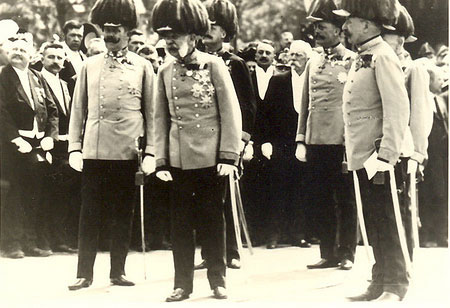
These tensions were also felt in the world of music – an art form that occupied a special place in the history and cultural identity of Vienna, as a major repository for some of the greatest composers in the history of Western music (Gluck, Mozart, Beethoven, Schubert, Strauss, Bruckner, among others). By the early 20th century, the Jewish impact on music and modernity had become so obvious that critics demanded to "stem Jewish music and Jewishness in music before they spread too far," as Philip Bohlman points out.
Richard Wagner's polemical writings (e.g. Das Judentum in der Musik)—tracing Jewishness in melody and speech, body and race ("inner spaces")—"unleashed a flood of responses to the presence of Jewishness in music, pro and contra."
The rhetoric shared by Wagner and his detractors stressed the ontological interority of music: das Judentum in der Musik (Judaism in music). As Philip Bohlman notes,
Rather than rejecting Wagner's anti-Semitism as baseless prejudice, most Jewish responses mounted counterarguments affirming the possibility of Jewishness in music, using the same terms, if not case studies, as Wagner and often embracing the racialization of music.Thus, Heinrich Berl in his essay Das Judentum in der abendländischen Musik ("Jewishness in Western Music," later published as a monograph with Wagner's exact title, Das Judentum in der Musik) not only accepted the charge that Jewishness in music inevitably embodied oriental traditions, but even rejoiced in "the richness of Eastern influences."
Richard Wagner held that the capacity of Jewish composers only to reproduce enabled them to enter European music history at a moment of historical collapse, in the aftermath of Beethoven's death in 1827. Bohlman points out that "Wagner's claim that Jewishness allowed only for the reproduction of music [indirectly] opened the historical door, emancipating Jewish music from ritual and recalibrating it as Western." Since Wagner held that Jewish musicians were essentially bricoleurs - who "assembled their performances from bits and pieces, borrowing or stealing when need be" – no Jewish innovations were to be expected.
On the other hand, as Thomas S. Grey points out,the Central European lingua franca of Yiddish was seen as "emblematic of a tendency to appropriate and distort all genuine cultural forms, from speech to writing to philosophical or political thought to singing, acting, and musical composition."The movement away from classical tonality was thus radicalized with Gustav Mahler's "tonal irony", and culminated with Schoenberg's atonal revolution — the dissolution and abandonment of tonal structures as an organizing system in favor of the radical constructivism that emerged with twelve-tone serial music: "With the progressive fragmentation of musical material — its decomposition into its smallest elements — the hierarchically ordered tonal structures, together with the restrictions they placed upon possible relations and combinations among tones, were dissolved."
The "emancipation of dissonance", according to Carl Schorske, not only destroyed harmonic order and cadential certainty: "By establishing a democracy of tones … [the] tonal relations, clusters, and rhythms expand and contract "like a gas", as Schoenberg said."
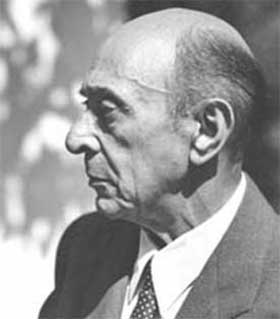
Schoenberg, as Leon Botstein points out, "sought to transmute a German national heritage—the pre-Wagnerian German tradition, seen as the universal in music— adequately into the twentieth century. In this way Schoenberg sought to dominate the musical world the way Wagner had, but in a manner in which all Jews… could partake as equals.… Like the inter-war protagonists of Esperanto, Schoenberg sought to fashion a new, valid universal modernist art in which both reason and emotion could be communicated and to which no social class, religion or ethnic group had claims of priority or higher status."
Since the Renaissance, Western music had been conceived on the basis of a hierarchical tonal order, the diatonic scale, whose central element was the tonic triad, the defined key. Musical events, thus, are not of equal importance: Some are structurally important, while others are primarily ornamental. Music, like linguistic discourse, is a time-oriented structure that progresses from a beginning to an end.
As Carl Schorske emphasizes,
The task of the composer was to manipulate dissonance in the interests of consonance, just as a political leader in an institutional system manipulates movement, canalizing it to serve the purposes of established authority. In fact, tonality in music belonged to the same socio-cultural system as the science of perspective in art, with its centralized focus; the Baroque status system in society, and legal absolutism in politics. It was part of the same culture that favored the geometric garden—the garden as the extension of rational architecture over nature.… The tonal system was a musical frame in which tones had unequal power to express, to validate, and to make bearable the life of man under a rationally organized, hierarchical culture. To make all movement fall in the end into order (the musical term is "cadence") was, appropriately, the aim of classical harmony in theory and in practice.
Ethan Haimo points out that with Schoenberg's atonal revolution, it becomes difficult or impossible to determine which of the tones in the chord is the unstable tone, and which are the stable ones:
When the dissonance cannot be identified, its resolution cannot be directed. And when that happens, the emancipation of the dissonance is at hand — not as the result of theoretical speculation about the more remote overtones of the harmonic series but as a consequence of the extension of the methods of chordal formation to include multiple altered and elabor-ative tones. … Schoenberg was not searching for stable intervals when he reached toward the more remote overtones of the harmonic system; instead, his principles of chord formation made it impossible to identify which tones needed resolution. The consequences of this are profound. If dissonance cannot be identified, it cannot be resolved. And if it cannot be resolved, then the very notion of consonance and dissonance becomes moot.
Consequently, some of the essential pillars of tonality were pulled down by Schoenberg: "The lack of directed harmonic progressions throws the existence of a tonic into doubt; the lack of hierarchy abolishes the diatonic scale as a referential collection; the inability to identify the dissonance erases the distinction between consonance and dissonance."
Nicholas Cook points out the "thread of violent political imagery [that] runs through Schoenberg's "Harmonielehre", as when he (Schoenberg) writes:The tonality must be placed in danger of losing its sovereignty; the appetites for independence and the tendencies towards mutiny must be given opportunity to activate themselves; one must grant them their victories, not begrudging an occasional expansion of territory. For a ruler can only take pleasure in ruling live subjects; and live subjects will attack and plunder.
Schoenberg talks of vagrant chords bringing about the destruction of the tonal system.
Cook also points out that "the overlapping of insider and outsider identities that coloured Viennese modernism is often seen as a specifically Jewish phenomenon," and that there was "a longstanding Viennese, or Habsburg, tradition … of associating music and social structure." He draws attention to "the network of terms connected with harmonic rootedness, terms which have a technical musical meaning yet at the same time carry the imprint of the political and racial discourses of fin-de-siècle Vienna":
These political and racial connotations tend to be spelt out more explicitly in Schoenberg's theoretical writings than Schenker's, and the term Schoenberg uses in his Harmonielehre to describe chords that lack rootedness immediately reveals what is at issue: they are "vagrant" chords. … Circumstances can turn any chord into a vagrant, he says … perhaps he was thinking of the displaced Ostjuden (later he might have thought of himself). … At all events he assigns a range of equally dubious attributes to his vagrants: they are "the issue of inbreeding", their character "indefinite, hermaphroditic, immature". It is possible for them to be assimilated (Schoenberg's phrase is "fit into the environment"), but when they appear in large numbers they "join forces", and "through accumulation of such phenomena the solid structure of tonality could be demolished"; elsewhere Schoenberg says that vagrant chords have "led inexorably to the dissolution of tonality".
In the 1920s, the conservative musicologist and critic Alfred Heuss attacked the "specifically Jewish spirit" of Schoenberg's music, which he saw as resulting from a "ruthless tendency to draw the very last consequences from a narrow premise." Annegret Fauser points out that Schoenberg's expansion of Wagnerian chromaticism pushed "quasi-polyphonic voice-leading to extremes."
According to Arnold Whittall, Wagner's use of "half-diminished" seventh chords to promote tonal ambiguity at moments of great dramatic tension and instability remained of absorbing interest in the writings of Arnold Schoenberg:
[T]he very "indefiniteness" of the Tristan chord has made it possible for theorists to regard it as a post-tonal or even atonal entity, thereby promoting that very breakdown of tonality of which Wagner's own practice stopped short. … [T]he tonally disruptive potential of the chord, and of Wagner's use of it, was well understood by those early twentieth-century theorists who were experiencing the consequences for composition of the breakdown of tonal order and, as they saw it, of the formal coherence that went with that order.
As Cook observes, Schoenberg ends up undermining the conservative discourses from which it borrows: The way Schoenberg turns a conservative argument against the archetypal "Other" into an affirmation of the role of the "Other" in the future of German culture, might be seen as "a deconstruction of the conservative discourse of hybridity":
It works by taking a political stance, translating that into musical terms, developing the musical argument, and then translating (or leaving the reader to translate) the conclusion back into political terms. In other words, it uses music to create an assertion about something other than music — in rather the same way … that television commercials use musical logic to make a point about hair dye or financial products (Cook, p. 310).
The birth of atonality was, according to Ethan Haimo, "the result of a single composer's intellectual and artistic makeup." Arnold Schoenberg's abandonment of tonality in 1908 and the development of the Second Viennese School were both symptom and cause of an ever-widening gulf between composers using music to make discursive political and aesthetic statements (a product of analytical reason) and a public that still yearned for the psychological satisfaction that comes from formal coherence.
From this perspective, Schoenberg can be regarded as Wagner's opposite, as a Jewish "Anti-Wagner". Wagner successfully claimed for art, according to Tim Blanning, "the function previously exercised by religion and arrogated in modern times by politics or economics." Schoenberg dethroned that position, by composing "irrational", atonalistic, fluid, "decentered" music, twelve tones "in free circulation, without any firm hierarchy or even distinction between the seven diatonic tones and the remaining chromatic tones."
As he declared in a letter (1909) to his colleague Ferruccio Busoni: "I strive for complete liberation from all forms … from all symbols of cohesion and of logic."
Part III: Transvestism in Music
The Austrian statesman Clemens von Metternich once declared that the Orient started southeast of the city walls of Vienna. Western Europe's centuries-long confrontation with Oriental empires helped define Central Europe as a cultural and his-torical frontier region. The experience of imperial sub-jugation and multi-ethnicity — an Eastern European patch-work of ethnic groups with different languages, cultures, and traditions living closely together — became essential parts of the Central European historical experience.
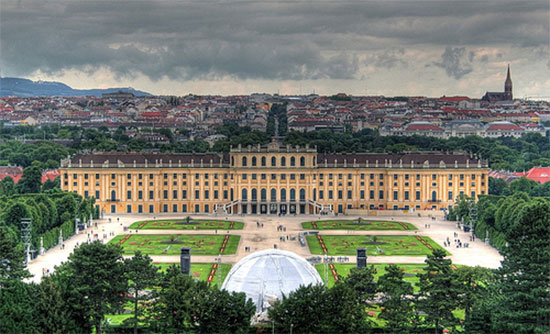
As Anthony Alofsin points out, the Austro-Hungarian Empire was "a collage of so many nationalities that it could never be transformed into a unified nation-state." Within this collage, Jews achieved cultural preeminence. The result, according to Robert Wistrich, was a multi-ethno-cultural encounter that "proved to be a cradle of modernism and post-modernism in the arts and sciences":
Schoenberg: Rome vs Jerusalem — Judea vs Germania?
Schoenberg's acknowledgement that he could not escape his Jewish heritage initiated a protracted period of reflection upon Jewish issues from both theological and political points of view culminating in the early 1930s with yet another attempt to give a comprehensive statement of his position by means of words and music — this time in his opera Moses and Aron, which presents his personal vision of Judaism.
The moment of truth is usually believed to have come in 1921, when he was asked for his certificate of baptism (to prove that he was not a Jew) while on holiday in Mattsee, near Salzburg (Austria). Schoenberg explicitly articulated his identification with a classically Jewish perspective and declared himself "no longer a European" but a Jew in a letter to the painter Wassily Kandinsky written in 1923:
For I have at last learnt the lesson that has been forced upon me during this year, and I shall not ever forget it. It is that I am not a German, not a European, indeed perhaps scarcely even a human being (at least, the Europeans prefer the worst of their race to me), but I am a Jew. I am content that it should be so! Today I no longer wish to be an exception; I have no objection at all to being lumped together with all the rest. … We are two kinds of people. Definitively!
Schoenberg's statements of an explicitly Zionist position begin in 1924, when he, according to Nicholas Cook, "argued that only military victory could secure a Jewish state in Palestine against its enemies." In The Biblical Way (1926) he presented his belief in the necessity of an exodus of European Jewry in the form of a psychodrama.
In a letter of 13 June 1933, after Hitler's rise to power in Germany, Schoenberg declared:
"It is necessary to give up all Western acquisitions; we are Asians and nothing essential binds us to the West. … We must return to our origins."A few weeks later, Schoenberg stated that he planned "a long tour of America, which could perhaps turn into a world tour, to persuade people to help the Jews in Germany." He explains that he considers this more important than his art, and that he is determined "to do nothing in the future but work for the Jewish national cause." On another occasion during the same year he states it explicitly: "I offer the sacrifice of my art for the sake of Jewry."
Although Schoenberg—whose ancestry included both rabbis and cantors—for a period of time discarded the Jewish faith for Lutheran Protestantism, the proximity of his ideas to Jewish theological thought remained obvious. Adorno had a point when he asserted that Schoenberg translated the Old Testament ban on images into music: Dissonance, defined as form divorced from imitation of external nature, can be seen as a revitalization of the Jewish ban on images. The need to change forms of expression in art is absolutely necessary in order to fulfill the old Jewish prohibition on images.
William E. Benjamin points out,
Schoenberg realized that Judaism provided a historical model for what he was attempting as an artist. He came to see that the Jewish concept of law — as mediation between an unknowable God and the task of constructing a meaningful social existence — offered a parallel, on a grand scale, for his efforts to devise a method of pitch organization that could mediate between the idea of a piece — an intricate web of tonal relationships that appeared to him instantaneously and as a unit — and the listener's need to follow a musical argument over time.
From the early 1920s, Schoenberg was, according to Gottfried Boehm, "committed to an uncompromising Hebraic monotheism through which he sought to legitimize his modernist experiment in musical expression." Robert Wistrich emphasizes the
"connection between Schoenberg's musical agenda, his Jewish identity and the commitment to a Jewish national renewal (by returning to the essence of ancient Judaism): The Mosaic aversion to idolatry, to visible symbols and mystery, are harnessed by Schoenberg to the cause of twentieth-century modernist expressionism."In Judaism, as in Islam, "it was sacrilegious to make a figurative representation of God. With very few exceptions, there were no Jewish painters before the Russian artist Marc Chagall, who had to come to Paris to paint."
Gleichgewichtsstörung: The Schoenberg-Kandinsky-Tango
Schoenberg's friendship and cooperation with the Russian painter Wassily Kandinsky — a philosemite who was erroneously listed as a Jew in the Grosse Jüdische National-Biographie (1929) — underscores the importance of the blurring of boundaries between art forms, as well as the underlying, religiously motivated, "aniconic" (i.e., without icons) or "iconoclastic" thematic structure. Music meant a great deal to Kandinsky; he referred to his own paintings as "compositions," and became deeply interested in Schoenberg's attempts to establish correspondences between musical tones and colors, and in his rejection of traditional tonal and harmonic patterns.
A new kind of transvestism among the arts was thus born:
We see a painter who wrote an opera libretto (Kokoschka) and a composer who painted pictures (Schoenberg). It is as if artistic talent were a kind of libido, an electricity that could discharge itself with equal success in a poem, a sonata, or a sculpture. Throughout the modernist movement, the major writers and composers both enforced and transgressed the boundaries among the various arts with unusual energy – almost savage at times.
As Christian Meyer, director of the Arnold Schoenberg Center in Vienna, points out:
The first decade of the twentieth century saw an almost simultaneous musical and visual revolution. Because of Schoenberg's innovations, musicians were freed from the system of tempered tonality. At the same time, painters, especially Kandinsky, broke away from the system of central perspective and figural representation. These traditions had been legitimated for centuries by an overwhelming number of masterpieces and were so universally sanctioned that they had come to be regarded as the unquestioned essence of both arts. This explains the anarchist energy that had to be unleashed to liberate music and painting from the bonds of tradition, and at the same time it illuminates the "atonal character" of pre-World War I painting in Europe, which reflects this revolution. While Schoenberg's music was an inspiration to Kandinsky as he explored abstraction, today Kandinsky's paintings function as ambassadors for Schoenberg's musical works. The strong colorful essence of Kandinsky's prewar works has the same richness of sound colors in Schoenberg's compositions.
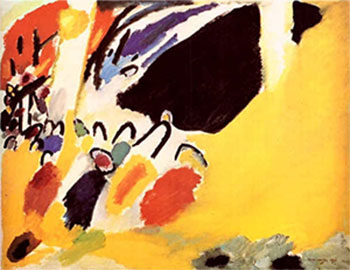
Schoenberg approved of Kandinsky's Der gelbe Klang with its "ungraspable" dimension, comparing it to his own Die glückliche Hand. Kandinsky explained to Schoenberg that Der gelbe Klang was based on the anti-geometrical type of construction attained "by the 'principle' of dissonance." Referring to the Ten Commandments in a letter to Schoenberg, he emphasized the power of negation and the difference between the law as a sign (word) and its signified (the meaning of the law). Kandinsky broke the link between the sign and a transcendental linguistic signified and hence equated art with reality. As with Schoenberg, the artistic form is conceived as pure perception — independent of external references.
Kandinsky and Schoenberg viewed their urge to change forms of expression as motivated by the desire to comply with the ancient Jewish prohibition against images. The old Jewish prohibition on images is characterized by its ability to uphold a separation between the pictorial and its referent, that is, the difference between the sign and what it signifies. Gottfried Boehm has emphasized the logic of concealment embedded in iconoclasm as a general condition of pictorial formulation or iconicity. From the Jewish prohibition on image, Boehm points out, the image is interpreted neither as a sign, substitute or thing, not according to the idea of depiction, "but rather as an apprehensible process which bears a striking similarity to language."
Schoenberg conflates music and language consistent with the idea that Jews have no tradition in the plastic arts. As noted by Kalman P. Bland, "Jewish aniconism implies that Jews are a People of the Book rather than a People of the Image. Proponents of Jewish aniconism deny the existence of authentic Jewish traditions in painting, sculpture, and architecture. They concede that Jews imitate, in production and reception, the foreign art of their host or neighboring cultures. … The Hebrews tended to think of understanding as a kind of hearing, whereas the Greeks thought of it more as a kind of seeing."
As ordinarily understood, truth results from the relationship between language and the world. It does not apply to the decorative arts or music where the traditional purpose was to produce an aesthetic feeling of appreciation — "aesthetic hedonism" or pleasure. However, Steven Beller cites Schoenberg's maxim "music should not decorate, it should be true," and suggests that his explicit invocation of musical logic represents an "invasion of the world of aesthetics by the ethical impulse of truth." Beller comments that "it does not seem improbable that this stemmed from attitudes whose origins lay in his Jewish background." Nicholas Cook agrees: "The whole debate about ornamentation … might be seen as resulting from the application to art of traditional Jewish thinking."
The Jewish position, inclined to abstraction as in the work of Schoenberg or Kraus, "stood in tension with the aesthetic hedonism of the official Catholic culture of Austrian society." No wonder, then, that shouting and scuffling accompanied the 1908 premiere of Schoenberg's Second Quartet in Vienna — a work that certainly did not result in aesthetic pleasure in the audience. A near-riot erupted on March 31, 1913, at an orchestral concert in Vienna in which works by Mahler, Berg, Webern, Zemlinsky, and Schoenberg were played.
At a personal level, Schoenberg was hardly a moral icon. Richard Taruskin points out that Schoenberg's personality "was as absolutist and despotic as any dictator's," and "his personal relationships could be repellently exploitative." Schoenberg's only name for skeptics, adversaries, or opponents was "enemies."
Nor was he shy about his own accomplishments. In endless pronouncements and anecdotes, Taruskin points out, Schoenberg claimed to have inherited the role of the Hegelian Weltgenie ("world-genius").
Nor are Schoenberg's own pronouncements on his role as a revolutionary to be taken at face value. The big step that others called the leap into "atonality," Schoenberg called pan-tonality or the "emancipation of dissonance." But, as Taruskin points out, it was not dissonance that had been emancipated: It was the composer who was liberated "from the constraints of "voice leading rules" whereby dissonance was subordinated to consonance in traditional harmony and counterpoint."
Wagner used the chromaticism of Tristan und Isolde to delay the harmonic resolution that would symbolize the slaking of sexual desire. That harmonic tension … was the mainspring that controlled the syntax of what we now call "tonal" music. Did the delays caused by Wagner's chromaticism attenuate that harmonic tension? Don't be silly. They only magnified it, vastly so. Wagner's chromaticism gave tonality a new source of strength and expressivity. The consequences Schoenberg drew from Wagner's musical style were entirely idiosyncratic and ahistorical, inevitable only in eyes blinded by "dialectic." To say the very least, they had nothing to do with Wagner's creative aims, least of all in Tristan.
Schoenberg's style recognized "no distinction between consonance and dissonance, so that harmonically speaking, literally anything goes." Schoenberg once cracked to a pupil, "Now that I've emancipated dissonance, anybody can be a composer."
While Wagner in his heyday took center stage, Schoenberg remained marginal or sectarian, as noted by Leon Botstein:
In contrast to Wagner, Schoenberg's music and the rhetorical strategy employed in its defense (designed largely by Schoenberg himself) never achieved wide acceptance. … From the beginning, in the face of controversy, Schoenberg's assertion of artistic integrity assumed a nearly puritanical façade of ethical superiority. Schoenberg's envy of Stravinsky, Ravel, Respighi, and Bartók took the form of high-minded moralizing about aesthetic concessions and superficialities.
As Jacques Le Rider pointed out, the utopias of mysticism, genius and narcissism – as responses to "feelings of solitude, ego-fragility, and instability" - had in common the striving to transcend limitations imposed by tradition: "they negate the male/female dichotomy and tend towards an androgynous ideal; they aim at the auto-destruction of a self that suffers because it cannot accept its contingent qualities (sex, race, etc.) and at the creation of a more perfect self." "Viennese modernism recognised that [the] old certainties had crumbled. The androgynism of the modern psyche and the inextricable commingling of Jew and non-Jew had given rise to bewildering confusion."
Taruskin notes,
Surmounting the major/minor dichotomy, voiding all distinctions between particular keys, was for him an achievement comparable to embodying androgyny or double gender. … To his pupil Anton Webern he confided that pantonality, like androgyny, "has given rise to a higher race!"
It has been suggested that the formation and assessment of systems in relativistic or quantum physics and atonalistic or dodecaphonic music are inspired by the same operative principles and insights, and that there is "a historical-cultural link between these two system mutations and the new world-view they produced" (e.g. probability taking over from determinism, the pivotal role of the observer, theoretical pluralism, etc.). In many respects the determinism inherent in tonality theory reflected the determinism in classical physics. In a similar fashion, quantum physics and atonality share an indeterministic rationale, affirmed in the principle of probability and in the disappearance of external determinism (tonality). Mark Delaere states, "In quantum physics external determinism and causality were toppled. The description of reality in terms of probability represented the triumph of ontological determinism over the mechanical determinism of classical physics."
The "twelve-tone idea" can be defined as a systematic circulation of all the twelve pitch classes based on "transposition, inversion, retrograde, and retrograde-inversion"; a shift from harmony as its principal structural determinant and toward counterpoint, reversing the stylistic change that occurred from Bach to Mozart by returning again to polyphonic thinking," as noted by John Covach.
Delighting in parody and outrage, the avant-garde, according to Richard Drain, "fought a guerilla war against bourgeois culture", the first onslaught of which came with futurism (launched in 1909), followed by Dadaism in 1916. Dada preferred non-Western cultures to "modern" culture, opposed all –isms, including modernism, favoured spontaneity and a cabaret environment, cubist paintings and cacophonous music. Relativity - a key modernist notion, invoked also by the Dadaists and the futurists - was used "to deflate the status of "objective" truth, license multiple viewpoints, and release them from the judgement of a final authority."
Indeed, transmutations parallel to the convergence between Kandinsky's painting and Schoenberg's twelve-tone music – a turning point sometimes described as a "Metaphysik des Schwebens", i.e. a "floating" condition between the subject and the world – can also be seen in a general shift away from apparently absolute certainties in the direction of relativity: Boasian anthropology, denying the concept of race; Saussurean linguistics, insisting that there are no positive quantities but only differences; Gödel's incompleteness theorem; the Heisenberg Indeterminacy Principle and the "Copenhagen interpretation", marking the advent of a "postmodern" science characterized by "paradox, uncertainty, and the limits of precise measurement"; Einstein's theory of relativity; Nietzsche's scorn for the unfounded pretences of religion, logic, or history; Freudian "decentring" of homo sapiens, not to mention expressionism, surrealism, absurdism, Cubism (Picasso's "extravagant deformations"), Dadaism, and atonalism in the arts. Charles Lemert has pointed out that the rise of the relativistic paradigm – or relativistic deconstructionism - was based on the conviction that reality itself is not self-evident and orderly. Relativism is critical of traditional rationality, uncritical realisms, strict tonalisms, objectivisms, and systematic explanations.
This development set off a chain reaction that paved the way for the critical dismantling of Western tradition and traditional modes of thought, the cultural logic of deconstructionism or The Culture of Critique, according to which "the Western ideal of hierarchic harmony and assimilation" was gradually destabilized and perceived as "an irrational, romantic, and mystical ideal." The outcome was a gigantic meltdown of a whole civilization's "cultural DNA structure," a transition to "liquid" (post-)modernity through a memetic "epidemiology of ideas," inventing a kind of "assembly line nihilism." The age of the gardeners has been succeeded by the age of the hunters and the order of chaos and wilderness.
Jacques Attali was right: music is prophecy. Music makes mutations audible.
As Taruskin emphasizes, removing the qualitative distinction between consonance and dissonance "eliminates the concept of the one being beautiful and the other ugly."
"The beginnings of Dada," Tristan Tzara declared, "were not the beginnings of art, but of disgust."
That disgust was reflected in Schoenberg's banal use of language in Die Sanftergebenen:
"O wie schön lebt sich's doch im Dreck" (Oh, how beautiful it is to live in the muck).
Without Schoenberg, undoubtedly, "our era would have made a different sound." Doubtless it would have been much more pleasing to European ears.
E. R. E. Knutsson is a freelance writer.
http://www.theoccidentalobserver.net/authors/Knutsson-DeconstructionII.html

